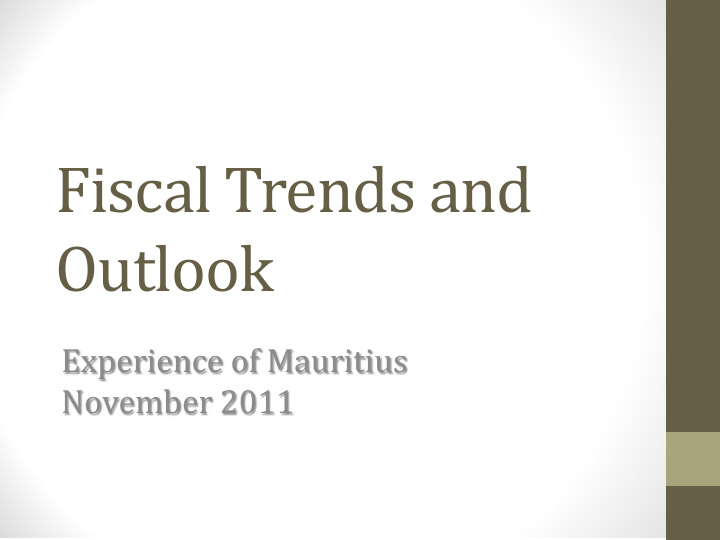



Fiscal Trends and Outlook Experience of Mauritius November 2011
Outline • 2005 – The turning point • Fiscal Reforms • Revenue • Expenditure • Public Debt • Procurement • Facing the Crisis • Outcomes • Fiscal Outlook
2005 – The Turning Point • Unfavourable International Situation • Sectors losing preferences • Macroeconomic situation deteriorating • High burden of Incentive Framework Failure of Model based on Trade and Tax Preferences/ Incentives
Reform Programme • Fiscal Consolidation and Improved Public Sector Efficiency • Improving trade competitiveness • Improving the Investment Climate • Democratizing the Economy through participation, social inclusion and sustainability. Shift from Trade Preferences to Global competitiveness
Fiscal Reform - Revenue • Complete overhaul of the tax regime • More transparent, simplified and rule- based • More efficient, investment-conducive and growth-friendly • More equitable and fairer Concerns only those who have ability to Pay And they pay at the very low rate of 15%
Fiscal Reform - Expenditure • Fiscal Rules to improve Expenditure and Debt Management • Medium Term Expenditure Framework (MTEF) • Shift from Line Budgeting to Programme- Based Budget (PBB) • Emphasis on services (outputs) & service standards • PBB is a process and changing mindsets takes time •
Fiscal Reform – Debt • Well-defined Debt Management Strategy – New Public Debt Management Act to control public sector debt and ensure long run debt sustainability
Fiscal Reform – Procurement • New Procurement Act • Central Procurement Board • Independent Review Panel • Procurement Policy Office • Project Plan Committee • Planning and Implementation Units • Design and Build approach –Pool of Experts –
Facing the crisis • Creation of special funds – May 2008 • Additional Stimulus Package – Dec 2008 • Expansionary Budget and monetary instance • Economic Restructuring and Competitiveness Programme (ERCP) • National Resilience Fund – Nov 2011
Outcomes • Tax revenue kept above 18% of GDP - sustaining the tax buoyancy • Real investment in public sector increasing • Quality deficit as it is financing only investment expenditure • Public debt as of GDP is decreasing
Evolution of Revenue and Expense Revenue, expenses and overall deficit as a % of GDP 25.0 20.0 15.0 10.0 5.0 0.0 00/01 01/02 02/03 03/04 04/05 05/06 06/07 07/08 08/09 Jul-Dec 09 2010 2011 Total revenue and grants Expenses Overall deficit (% of GDP)
Total Public Sector Debt and Overall Deficit as a % of GDP 80.0 7.0 Overall deficit 70.0 6.0 60.0 5.0 50.0 4.0 40.0 3.0 30.0 2.0 20.0 1.0 10.0 0.0 0.0 00/01 01/02 02/03 03/04 04/05 05/06 06/07 07/08 08/09 Jul-Dec 09 2010 2011 Total Public Sector Debt Overall deficit / surplus
Projects with private sector involvement (Rs million) Total Project Projects 2012 2013 2014 2015 Value 2011 -2015 Wind Park at 1,800 1,200 600 1,800 Curepipe PPP Road 20,793 949 4,383 10,596 4,866 20,794 Decongestion Driver Education 200 50 100 50 0 200 and Testing Centre Management of Fish Auction 15 15 0 0 0 15 Market TOTAL 22,808 2,214 5,083 10,646 4,866 22,809
Fiscal Outlook • Budget deficit will be further reduced as expenditure is reduced and revenue increased • Debt to GDP ratio will continue on the downward trend • Assuming the World Economic Outlook does not deteriorate further.
Conclusion • Performance is due to reforms • Some reforms are knowledge-intensive like PBB . Need to build capacity through peer support and peer learning exchange programmes to build a pool of expertise within Governments to serve the wider region • An eye on the WEO.
Recommend
More recommend